Preface
Visiting the excavations of Ostia is one thing. Visiting the mediaeval village Ostia Antica is another thing, but very few people do it. Those who do not go to the mediaeval village miss one of the most beautiful and relaxed places in Italy. They miss the mediaeval wall and castle. They miss the seat of the bishop of Ostia, who blesses each new pope. They miss the church of the martyr Saint Aurea. In her church part of the funerary inscription of Monica, the mother of Saint Augustine, can be seen. She died and was buried in Ostia. They miss the arches of the aqueduct leading to Ostia - arches that are still visible in the mediaeval walls. They miss the hang-outs of the archaeologists: Bar Centro (led by Maria, Tonino and Francesco) and Ristorante Monumento (led by Giampiero and Andrea). And they miss a large red-purple house that carries, in large letters, the name of a family: MENGHI.
On Saturday November 18 2017 Jan Theo Bakker interviewed a member of the Menghi-family: Tonino Menghi (not to be confused with the owner of the bar). Mister Menghi is known for his short and powerful poems about culture and family, written in the Roman dialect. We met in Bar Centro. The interview took place in Casa Menghi.
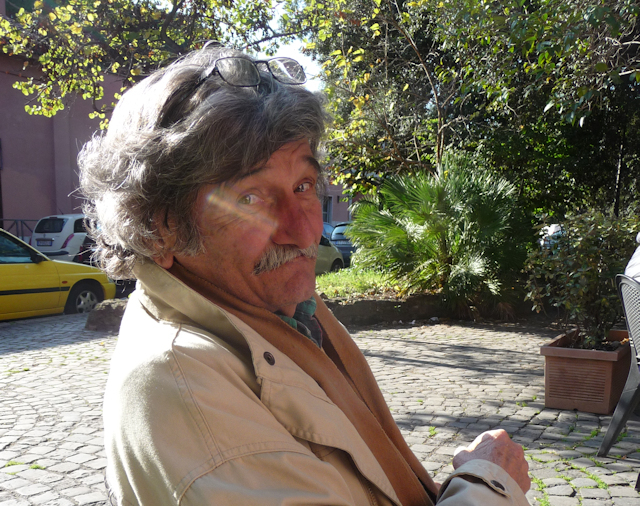 Tonino Menghi with a ray of sunlight at Bar Centro. |
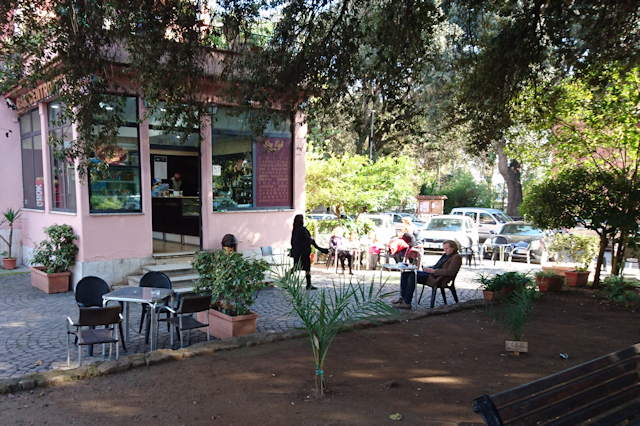 Bar Centro (in 2024 renamed Smash Caffè). |
Mister Menghi, to begin with: when and where were you born?
I was born in 1944 in this house, on the second floor with the terrace. And yes, I wrote a poem about that also, accompanied by a photo with arrows, pointing to the various rooms in which I lived. There were some problems with the birth. The midwife lived in Lido di Ostia and had to be picked up by bike, because the Germans had destroyed the railway. A doctor was living in the public medical premises, just here in front, but he was ill. In the end a kind woman, named Stella, also living on the second floor of the house, made sure everything went well.
When and why did your family come to Ostia?
That is a long story. Until 1870 Ostia, its salt pans and marshes, were part of the Papal State, while a large part of the agricultural area was - and still is - property of the aristocratic Aldobrandini family. The Italian state wanted to drain the salt pans and marshes, to make the land usable and to fight the malaria here. This work is known as the "bonifica" and it had already been done near Ravenna in the north-east of Italy, where my family is from. Many people in Ravenna migrated to Ostia to do the same work, because they had a lot of experience with it. This took place in November 1884. My family, led by my great-grandfather Antonio Menghi, his wife Giulia Zanzi, and their son Amedeo arrived soon afterwards.
Did the house (now Casa Menghi) already exist then?
Oh no! Only a handful of people lived in Ostia then. The only buildings were the mediaeval village, the castle and the Casalone del Sale, the Salt Building, near the salt pans. This by the way is not the Salt Building that is now the museum, but a different building, here in the mediaeval village.
Please tell us more about the arrival of the people from Ravenna.
This took place in three "waves", so to speak. The first wave was quite small: it consisted of just a few people who prepared Ostia for the workers. Then the workers arrived: about 500 in total, including 50 women. The precise figures remain uncertain. What is known is that the majority of them stayed in Fiumicino, where the whole group arrived by train. About 220 came to Ostia, crossing the Tiber at Tor Boacciana by means of the "scafa", the ferry. The people in Ostia needed butchers, bakers and so on, and this was the third wave. My great-grandfather, Antonio Menghi, was a shoemaker, who lived in the Romagna, in a part of Ravenna called Campiano - Borgo Muratori. He was part of the third wave. You can still see his tombstone in the graveyard of Ostia. All these people lived inside the mediaeval village.
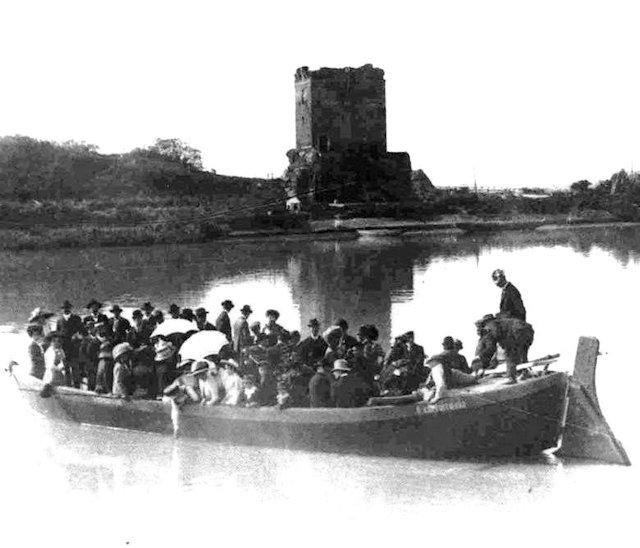 The "scafa" (ferry), for the route Fiumicino - Isola Sacra - Ostia Paese. Behind is Tor Boacciana. |
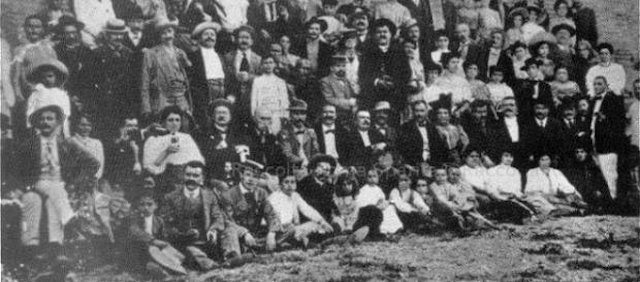
"At that time the only way to reach Ostia from Fiumicino and the Isola Sacra was crossing the river at Tor Boacciana, by means of the "scafa", the ferry." "Following the arrival from Ravenna, the group of Romagnoli, destined for Ostia, after the overnight stay together with those destined to remain in Fiumicino, set forth and walked to Ostia, with their handbarrows and working tools. They crossed the river by means of the "scafa" and arrived in Ostia, where they settled in the Borgo, in various houses and premises of Aldobrandini and of other owners, where they remained permanently, even after the end of the "bonifica"." |
How did your family survive, economically?
That was the work of my grandfather, Amedeo Menghi, a die-hard Republican, who never named his children after saints. Therefore in our family we have names such as Raoul, Oberdan and Oscar. Amedeo was a shoemaker as well, but he turned out to be a businessman. In 1911 there was a big event in Rome to celebrate the 50th anniversary of the Italian unification. Here Amedeo, after obtaining a licence from the government to sell salt and tobacco, bought a prefabricated bar. He took it to Ostia - Ostia Paese as it was called then, not yet Ostia Antica - and called it "Antico Châlet Menghi". It was placed very close to the present day Bar Centro. It may even be a predecessor of Bar Centro.
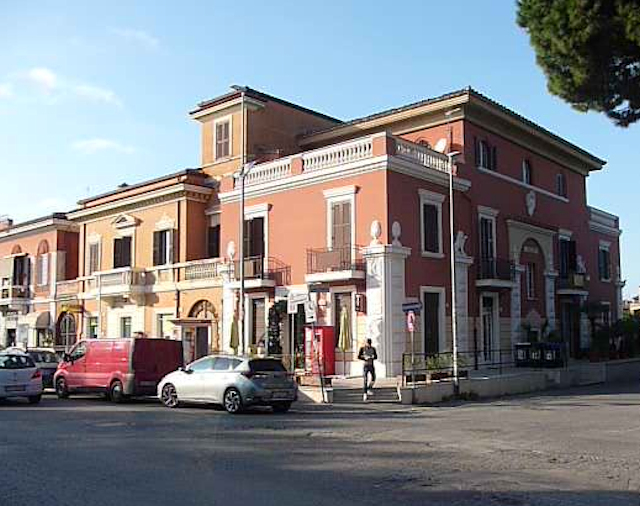 Casa Menghi in 2017, seen from Bar Centro. |

"This advertisement appeared in a special issue of a newspaper called "Il Gazzettino Balneare del Tirreno". It was issued on August 10 1924, the inauguration day of the Roma-Ostia-Lido railway. I think that it was a special and unique issue, just for that occasion. It contained a lot of advertising, mostly of local operators and traders, like my grandfather." "At that date, I suppose, the châlet should have been at its final phase of usage, because the ground floor of the Menghi house was built in 1923 and the activities had moved there gradually. Based on this advertisement it seems that in August 1924 not all of these had yet been transferred. It is also possible that, even if all the activities had been moved to the house, my grandfather wanted to maintain the name of the previous location as a brand, commercially well known in the area and probably even in Rome." |
So Casa Menghi still did not exist?
Correct. Amedeo and his wife Francesca lived with seven sons and one daughter in a very small house in Piazza della Rocca, inside the mediaeval village. To have an idea of the living problems of those days, consider that the seven sons were sleeping all together in one bed, while the daughter had a separate small bed, in the same room, full of humidity and cockroaches. Pushed by these problems and thanks to the improved economic conditions, he was able to buy a piece of land from the Prince Aldobrandini, where the house is now: at the corner of Viale dei Romagnoli, as it is called today, and Via delle Saline, that didn't have a name yet in those days. In 1923 he built the ground floor, which consisted of seven rooms to which he transferred his activities from the châlet, which was dismantled. Tobacco and wine were sold, there was a trattoria, and parties were facilitated by setting up tables. The room in which we are talking now was given for rent as a barber shop. Slowly more houses were being built outside the village. In 1929 two floors were added to Casa Menghi. The last work took place in 1958, by adding a complete wing with terrace on the right side, which made the house symmetrical according to the original intention of my grandfather, who didn't have sufficient money for completing the house in 1929.
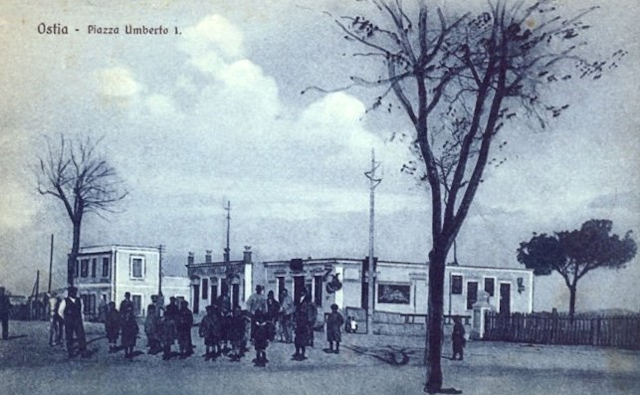
"A bureaucratic paper that I obtained twenty years ago from the technical office of the Comune di Roma says that the ground floor of Casa Menghi - the house on the right - was built in 1923 and that it consisted of seven rooms, all of them defined as "shops". At the middle corner of the house - the south-east corner, exactly in the centre of the picture - a round advertising panel of Fernet Branca is visible, distinguishable by the wing of the eagle. The door on the right, close to the pine tree, was the barber shop - the room where we are talking now." "The house in the middle was property of the Visca family that is still living there and owner of the first and second floor, while the ground floor now belongs to the Poste Italiane. At the time of the picture it was an osteria, selling wine and perhaps providing a little food." "The house on the far left is still the same. It was built by the Felici family, who installed there an osteria and caffè. Many osterias and caffès were active at those times! It is now hosting the farmacia." "The wooden fence visible on the right side of the picture is delimitating the Condotta Medica, the public medical premises set up around 1923 to operate against malaria." |
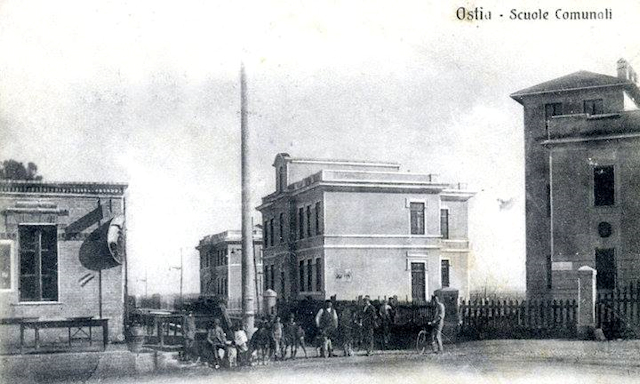
"This photo was taken from the south, not from the south-east like the previous one. The group of people present here seems to be the same as that in the previous picture: boys and adults, one of them wearing a white shirt and having a horse. Looking at the shadows and at the people it appears that the previous picture was taken at the same time and on the same day as this one." "Tables and chairs are visible outside Casa Menghi (on the far left), confirming the bar activities. On the corner of the house the advertising panel of Fernet Branca is visible. The bricks of the facade were of a gray color and very particular, made by mixing lime and seasand. The brick factory was in Ostia Lido and operated by a German process. The main church of Ostia Lido consists of the same type of bricks, red-coloured." "The building in the center is the primary school, that for many years gave the name to the street to the left: Via delle Scuole, then changed to Via delle Saline, which is the present name. Behind the school is the "Casa delle Maestre" (House of Teachers), built there to enable the teachers to live close to their job site. Behind that house, still belonging to the Comune di Roma, some years ago archeological findings emerged during earth moving activities for building a daycare. Everything was stopped by the Soprintendenza and the matter is still waiting for decisions. On the right is the Condotta Medica." "The road has concrete poles for public lights, denoting that electricity had arrived. My father repeated to me many times that when electricity arrived there was great enthusiasm among the residents." |
How did your grandfather feel about fascism and Mussolini?
Well, as a republican my grandfather was against fascism and for this he was subject to some controls and limitations by the regime. He couldn't move freely from one place to another, or at least there were cases where he had to ask for permission, like for instance on an occasion where he needed to go to Lido di Ostia for the annual control and stamping of scales used for the sale of salt and other products. I have a small sheet of paper signed by the local commander of the Carabinieri, which authorized him to go. It was July 20 1943, only five days before the fall of Mussolini, who was replaced by Badoglio. In spite of these controls, I heard in my family that he liked to wear red shirts when the dominating colour in Italy was black, and he had troubles that even led to a forced closure of the bar. One day the re-opening permit was personally promoted by Mussolini, who had arrived by car in front of the house, in a red Alfa Romeo driven by himself. Having read on the house front "All'antico Menghi il Romagnolo" - Mussolini was Romagnolo as well - he asked my grandfather: "Menghi il Romagnolo, is it possible to have a drink?" The answer was negative, because the bar was closed and the shop was kept open only for the sale of salt and tobacco, which were government products. Mussolini went away, but after a few days the re-opening permit arrived. According to a repeated narration by my father, Mussolini apparently found another occasion to have lunch - or at least a snack - here. He told me so many times that, coming home by bike for lunch from the scavi, where he has been a labourer for many years, he was forbidden to enter the house because "Mussolini was eating inside". My father entered from a backdoor and he could eat without any problems and go back to work.
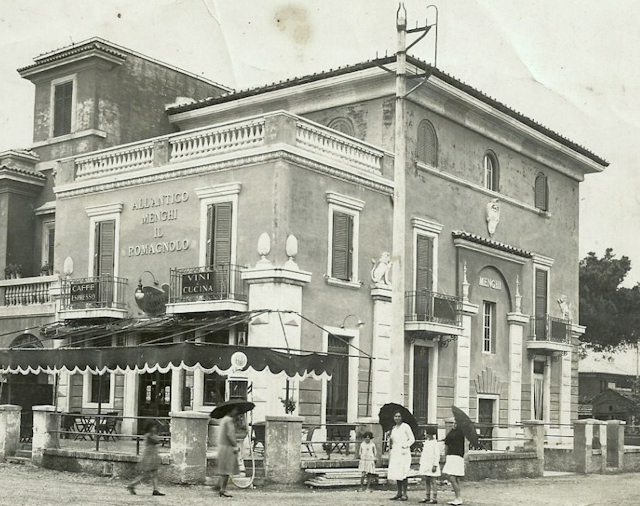
"This picture was made in 1931, just two years after the transformation of the original construction into a two-floor house, in a mixture of pretentiousness and coquetry. The name of the architect is unknown. The family moved there in 1929 from the two-room house of Piazza della Rocca and, at that moment, the eight children of my grandfather had a better space, even if not too much. As a matter of fact, the house was not made up of apartments but of rooms that were numbered, as in hotels, and my grandfather gave them for rent. This means that the family was confined to a limited number of rooms." "Probably with the aim of being easily identified, my grandfather wrote the name Menghi on the main facade, on via delle Saline, while on the lateral side on Viale dei Romagnoli he wrote "All'Antico Menghi il Romagnolo". I think that, for commercial appeal, he intended to maintain the word "antico", already present in the "antico chalet", and that he added the attribute "romagnolo", of which he was undoubtedly very proud, like all the romagnoli that I've met in my life." "The writings "Caffè espresso" and "Vini e cucina" on the balconies have in the middle a metal plaque with a lamp, with the indication "Sali e tabacchi" and the number of the Monopoly of State concession: No. 255, that today is the only unchanged thing. The tobacco shop is still there. Behind the woman with umbrella, on the left, an Agip filling pump is visible. It has been active for many years, probably till WWII. In a year in which it gave particularly good results in terms of revenues, my grandfather purchased a piano for his only daughter Dolores. The piano was stolen during WWII, but then found and brought back home." |
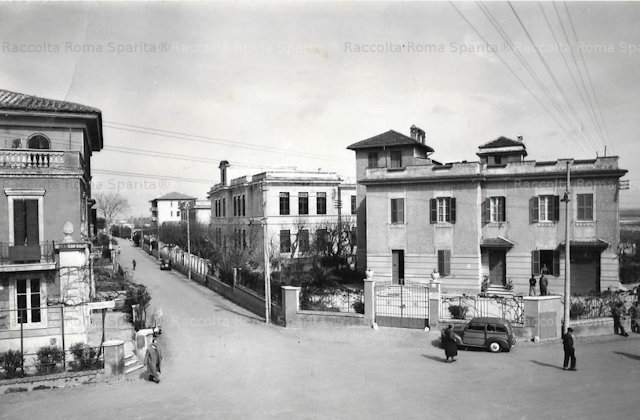
"Nostalgia of the 1950's. The traffic situation today is much different!" "The house today, after a last painting with colors that are more or less identical to the original ones, still looks very good and makes us proud of being its inhabitants, although terrified by traffic jams and traffic noise. When my grandfather chose that place to build the house, at the corner of the two main streets (we must consider that the Viale dei Romagnoli was still the Via Ostiense in those years, arriving in front of the house directly from Rome), for sure he was motivated by the hope to have traffic and clients. Today I'm led to think that his original hope has been satisfied... even too much!" |
We are now getting close to the huge excavations in the years 1938-1942 for the World Exhibition that never took place (Esposizione Universale di Roma, EUR). Was your family involved in any way?
My father Raoul was a labourer at the scavi, mainly involved in preparing the mortar for the restorations of the ruins, which were unearthed at a high pace for the approaching Esposizione Universale. Of course he knew Guido Calza and his wife Raissa Calza. Raissa, a former Russian ballerina, was not very popular amongst the workers. This is what I understood from my father but, however, I have a book, "Ostia", written by her in the '60s of the last century, where I learned a lot of particulars on our old town. Unfortunately my father did not get a job at the excavations after WW II, as shown in a letter of 1946, signed by Guido Calza, in answer to an application presented by my father.
What happened after 1942?
July 25 1943 is the date of the fall of Mussolini. On September 8 1943 there was an armistice between Italy and the allied forces. However, the German forces then immediately occupied Rome. The Germans feared an allied landing at Ostia. And that did take place, not at Ostia however, but at Anzio. All people in Ostia had to leave the town - a zone five kilometres deep. As a first step they were taken to houses in the campagna, later to Rome. The whole Menghi family stayed in a modern construction in the Garbatella area, except for my parents, who preferred to stay with some relatives of my mother in a military camp called Campo Parioli, which in 1960 would become the Olympic Village.
When did the family return?
After the liberation of Rome. Rome was liberated on June 4 1944 by US forces led by General Clark, coming in from the south, after the fighting at the beaches of Anzio and at Monte Cassino. The sanitary premises opposite our house had been used by a German commander, our house by German troops. Much had been stolen: a piano, a complete window, and other things, while all the documents and photos of the family had their final end in a stove used by Germans to face the 1943 winter. In those years there was still malaria in the area, which was eradicated later by the US troops, who sprayed DDT.
Now how about your life after WW II?
I studied Chronometria, namely watch design and construction, in Rome. After military service I started working for AlItalia in 1969. Next I worked for a small company in the ENI Group (oil and gas sector), doing organization and training. Many missions of various duration took me to a lot of countries, such as Iraq, Libya and Nigeria.
So you did not see much of Ostia Antica and the excavations after WW II?
I did, shortly after the war, but I was a child. In those years only people living in the village worked at the excavations. Children from the local school would often go in for free and spend some hours on the grass to the north of the Grandi Horrea, near the museum. It was easy to get in for free then, by the way, because there were no fences. Also, locals were permitted to enter freely to celebrate 1st of May, and were even invited to see the final rehearsal of performances in the theatre. Consider that the first experimental performances in the partially restored theatre, in the 20s of the last century, were made with children from the local primary school.
Is that still the case?
The situation has changed. In the early 20th century archaeologists, such as Dante Vaglieri, lived here, in the castle. The castle did not have a toilet, by the way, but I leave that to your imagination. Today the archaeologists live far away from the village, so there is little synergy between them and the locals.
Did you meet archaeologists when you were young?
A few. I know that Giovanni Becatti lived in a large yellow house just outside the excavations - to your left just before you enter the site. The house was designed by Italo Gismondi. Anton Luigi Pietrogrande, who has been director of the excavations, was always very cold, even wearing a coat in August. His nickname here was "Doctor Seven Coats". And of course we all knew Professore Capelli Lunghi, the professor with the long hair: Russell Meiggs. One day, in the 1950s, I was on the street when he asked me the directions for the Casalone del Sale. I pointed him the way. Also, I was acquainted with restorers of the wall paintings, such as Alberino Vicari and Augusto Calderoni. They had been working together with Omar Al-Mahjub, who was active in Lepcis Magna in Libya. I met Omar by chance in Libya when I was there, working for my company.
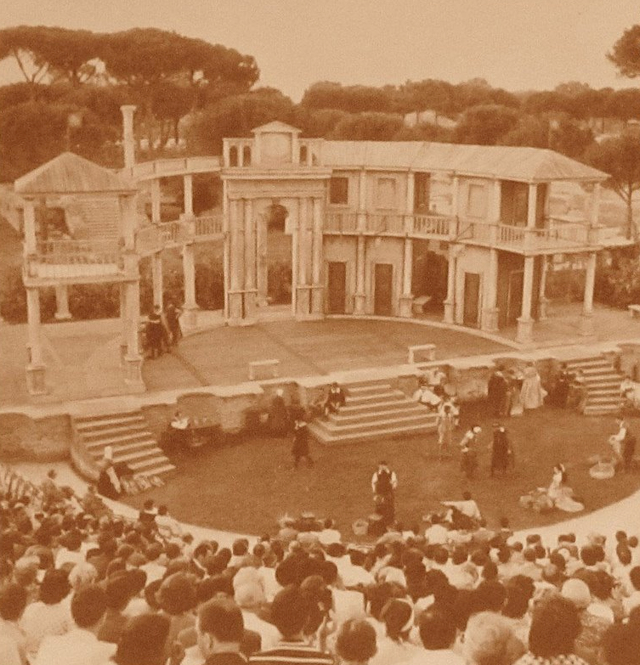
An early theatrical performance in the theatre of Ostia. Similar performances still take place every year, in the summer, when elaborate stage buildings are erected. |
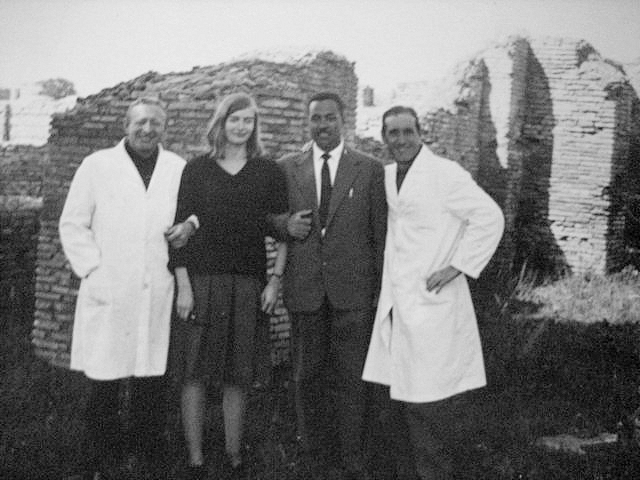
Two restorers of the paintings in Ostia: Alberino Vicari (left) and Augusto Calderoni (right), together with Omar Al-Mahjub and an unidentified archaeologist. |
Many houses in Ostia Antica, built after 1884, are right on top of tombs flanking the Via Ostiensis, the road leading from Ostia to Rome, on top of the salt pans and the marshes. Surely a lot of ancient remains must have been found when the houses were built?
That is correct. My father has told me repeatedly that Casa Menghi was built on top of tombs. However, spectacular finds have never been made here and there was hardly any archaeological research. Illegal excavations took place on the Pianabella to the south of Ostia, in the necropolis. I've never been a tombarolo and I like objects to be in the museums.
How does it feel to live here after all those years of travelling?
I had a dynamic working life, involving many work sites and a continuous moving from one guest house or hotel to another, and from one bad canteen or restaurant to another. This from Iraq to Nigeria, from Saudi Arabia to Pakistan, and from Algeria to Egypt and Libya, and to other countries, up to Venezuela. Training people, organizing and holding seminars on materials and maintenance management, writing organizational texts and technical specifications, and so on, both in English and French. I always said to myself: "When you are a pensioner, you need a quiet and relaxing life, not moving from your premises, not moving from your preferred bar".
Epilogue
At the end of the interview I take a smoking break with a glass of red wine, kindly provided by Mister Menghi, in his garden. I see various fragments of inscriptions amongst the tiles on the floor. These must have popped up in the area. All funerary. VIXIT. DIS MANIBVS. BENE MERENTI. Then I spot a tiny fragment and I am stunned. DD. SING. Followed by a consular date. "Mister Menghi, this is really important!"
Yes, I know. My nephew Oberdan has studied it and he believes that it is from 171 AD. I am more than willing to give this and the other fragments to the Soprintendenza!
Mr. Menghi, after this interview and thanks to his nephew Oberdan, who is an archaeologist, contacted the Parco Archeologico di Ostia Antica (this is the new name of the archeological area that includes the scavi), making them aware of the fragments in his possession. The scavi made a survey and the decision taken was to leave the fragments where they are, because they were properly kept and conserved. Photographs were taken and a letter was then addressed to Mr. Menghi containing pictures and a general description of the items, and declaring him officially as owner and responsible for them. All is well that ends well!
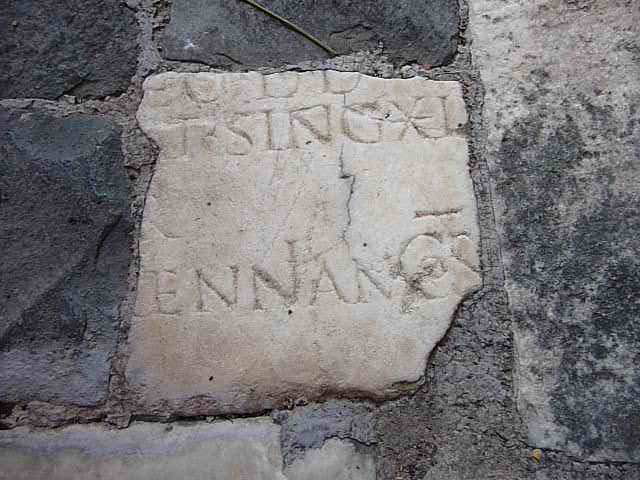
Fragment of an inscription with a consular date, in the garden of Mr. Menghi. Possibly from 171 AD: [T. Statilius Severus and L. Alfidius Her]ennianus. To prevent theft, the fragment is today covered by a heavy concrete basin. |
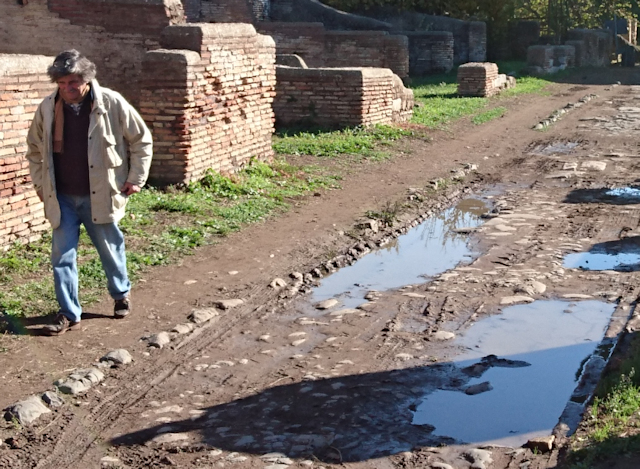
"When you are a pensioner, you need a quiet and relaxing life ..." |